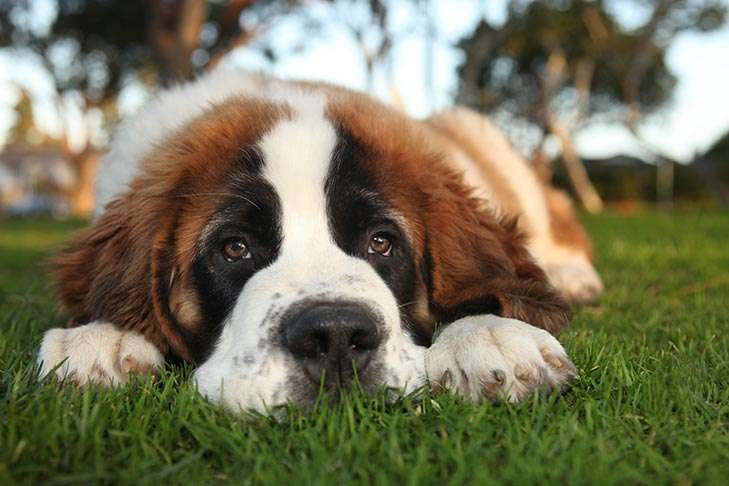
Anxiety is not only a common trait in humans, but animals can also suffer as well. Many of the dogs in our care have anxiety — which usually stems from being abandoned by their owners and the shelter environment in general.
Just like with other unhealthy behaviors — biting, barking, chewing on everything in sight — anxiety can be treated. Anxiety can be totally cured, but sometimes it can only be managed; noticeable under certain circumstances.
If you have a dog that suffers from anxiety, this post is a must-read. We’ll outline several proven methods for supporting your anxious dog and promoting a happy healthy life.
So let’s take a look at what can cause your dog’s anxiety and the most common proven ways to calm your anxious dog.
Anxiety in Dogs
Anxiety can manifest itself in multiple ways, from whining and barking to shivering and whimpering. You may also find that your dog becomes destructive or hostile when anxious. Over time, they may lose their appetite and become completely withdrawn if the anxiety is not addressed.
The most common reasons for anxiety in a dog is abandonment, fear of being home alone, loud noises, traveling, and/or being around strange people, children, or other pets. We’ve also seen the anxiety in dogs that have been abused or neglected.
The best way to treat your canine companion is to determine the cause. Anxiety is usually evident and easily identified. Once you pinpoint the reason, you can go about treatment management.
7 Proven Ways to Calm Your Anxious Dog
1. Exercise Your Dog
If your dog has separation anxiety, the obvious way to ease their mind is to never leave them alone. That is not a reality for most pet owners, so using exercise as both a bonding time and to tire out your pet is often an easy fix!
Because anxiety can cause an excess of energy, taking your dog out to play ball or on a long walk before you leave can be helpful. Providing plenty of physical contact and talking to them during this time is also beneficial. And, like their human counterparts, exercise can help relieve stress by producing beneficial endorphins.
Check out our recent guide: How to Exercise Your Dog
2. Physical Contact
There is probably nothing more soothing to an anxious dog than its owner’s touch. Try to identify the signs of anxiety in your dog and nip them in the bud as early as possible by picking them up, cuddling on the couch, or giving them a good long petting session.
3. Massage
As you probably know, a massage will relax and calm even the most anxious human — did you know it also works wonders with dogs as well?! Anxiety often causes tensing of the muscles and massage therapy is one way to alleviate tension. Start at the neck and work downward with long strokes. Try to keep one hand on the dog, while the other works to massage. Over time you may even be able to identify where your dog holds its stress and just work on that one particular area.
4. Music Therapy
Music therapy has been proven to be beneficial for both humans, as well as our canine and feline friends. The power of music can be calming and relaxing while you’re home, in the car, or away from your pet. Music can also alleviate noise sensitivity by blocking the street or scary noises that bother some dogs and create anxiety.
Research has shown that many dogs prefer classical music. Harp music, often used in hospice situations, can be a natural sedative. You might try:
- Through A Dog’s Ear by pianist Lisa Spector and psychoacoustics researcher Joshua Leeds
- Noah’s Harp: Surrender by Susan Raimond
5. Time-Out
While anxiety isn’t a bad behavior per se, it can help to give your dog some time-out when they’re acting out. Isolating your pet in a safe and quiet space can help calm their frayed nerves. Maybe that space has some very quiet music playing, low lights, and/or some aromatherapy available (see below “Alternative Therapies”).
You might also try a ZenCrate for time-outs, and as a general escape pod for your furry friend. The ZenCrate was designed to help dogs with a variety of anxiety factors. It’s similar to a standard crate but it provides vibration isolation, noise cancellation (through sound insulation), reduced light, as well as comfort and security. A motion-activated sensor turns on a gentle fan when your dog enters, which helps block noise and provides a steady stream of fresh air. You can pre-program the crate with music. It comes with a removable door, so your dog can self-comfort and enter at any time.
6. Calming Coats/T-Shirts
Calming coats and t-shirts apply mild, constant pressure to a dog’s torso, surrounding a dog much like a swaddling cloth on a baby. It’s recommended for dogs with any type of anxiety induced by travel, separation, noise, or stranger anxiety.
Depending on the size of your dog, there are several brands and models to choose from. You can check out ThunderShirt Anxiety Jacket, American Kennel Club Stress Relief Coat, and the Comfort Zone Calming Vest.
7. Alternative Therapies
While there is limited evidence that alternative products can be of benefit to dogs suffering from anxiety, the products listed below are non-invasive and will cause no harm. They are therapies that can be used alone or combined with those above to be more effective. Be sure to do proper research before implementing alternative therapies, and consult with your veterinarian, too.
Rescue Remedy for Pets
Rescue Remedy is part of the Bach homeopathic line of remedies for humans. Homeopathy was founded over 200 years ago and is popular in Europe and England. (The Queen even has her own Royal Homepath.) It is based on the principle of similarity and uses plants and flower in all remedies.
Rescue Remedy Pet is comprised of 5 different Bach Flower Remedies that constitute a stress reliever. It is completely safe to use on your dog. You just add 2-4 drops directly to their drinking water. There is also a spray that you can use on pet bedding and toys.
Note: There are other homeopathic remedies that can be used on pets for specific issues, like constant barking, intolerance toward strangers, or loss of an owner. For a full list, check here.
Supplements
There are dog treats that contain helpful supplements proven to help anxiety. Typically they will contain melatonin, thiamin, chamomile, L-Theanine or L-tryptophan. Some also have a ginger element to help with sensitive stomachs. These are often recommended for general and travel anxiety.
Adaptil Home Diffuser
Adaptil is basically aromatherapy for dogs! It uses pheromones to help allay fears, much like a nursing mother gives off to her puppies. It is easy to use: just plug the diffuser into the room your dog spends the most time in. The diffuser releases “dog-appeasing” pheromones, an odorless scent particular to dogs. (Humans, cats, and other pets will not smell anything.)
For puppies, you can also use Adaptil’s lightweight collar that can be worn until they’re 6 months old, which helps with the inevitable separation anxiety.
ThunderCloud
This unit combines music therapy with aromatherapy to help calm your dog by using both auditory and olfactory senses. The sound machine can play a variety of calming loops, such as a babbling brook or relaxing waves lapping at the shore, while the essential oils combine several known to be calming, like lavender, chamomile, and geranium. Good for dogs with noise sensitivity, separation anxiety, and to help them sleep through the night.
If you find that the above treatments are not the answer for your dog and their anxiety, it’s best to consult your veterinarian. There are a variety of prescription medications available for separation anxiety and destructive behavior that could be beneficial.
Just like humans, dogs experience anxiety. While unpleasant, it is a normal and also healthy emotion. Dog anxiety can affect all breeds, but may affect each individual dog differently. Although it is something that all dogs experience from time-to-time, if disproportionate levels of anxiety are left unchecked, a dog can develop an anxiety disorder. If left untreated, dog anxiety can lead to behavioral and other issues.
How do you know if your dog has anxiety? What can you do to treat dog anxiety? We’re here to explain everything you need to know about dog anxiety — common causes, symptoms, and treatments. Additionally, we’ll discuss top tips for anxiety prevention. This way, if your dog ever does suffer from anxiety — you’ll have all the knowledge you need as an owner to help.
Dog Anxiety: Causes
According to the Merck Veterinary Manual, dog anxiety can have a variety of causes. Some of the most common causes of dog anxiety are:
- Fear
- Separation
- Aging
Fear-related anxiety can be caused by loud noises, strange people or animals, visual stimuli like hats or umbrellas, new or strange environments, specific situations — like the vet’s office or car rides — or surfaces like grass or wood floors. Although some dogs may only have brief reactions to these kind of stimuli, they may affect anxious dogs more consequentially.
Separation anxiety is estimated to affect around 14 percent of dogs. Dogs with separation anxiety are unable to find comfort when they are left alone or separated from their family members. This anxiety often manifests itself in undesirable behaviors, such as urinating and defecating in the house, destroying furniture and furnishings, and barking.
Age-related anxiety affects older dogs and can be associated with cognitive dysfunction syndrome (CDS). In dogs with CDS, memory, learning, perception, and awareness start to decline, similar to the early stages of Alzheimer’s disease in humans. This understandably leads to confusion and anxiety in senior dogs.
Dog Anxiety: Symptoms
So how can you tell if your dog has anxiety? There are several important symptoms to look out for:
- Aggression
- Urinating or defecating in the house
- Drooling
- Panting
- Destructive behavior
- Depression
- Excessive barking
- Pacing
- Restlessness
- Repetitive or compulsive behaviors
Some of these symptoms may be the result of occasional anxiety-causing events, but any of these can become recurrent and therefore, result in more serious issues. This being said, by far the most dangerous symptom of dog anxiety is aggression. This aggression can be targeted directly or indirectly, depending on the situation. Direct aggression occurs when a dog acts aggressively toward people or other animals. Indirect aggression can be equally dangerous, and often happens when a person comes between the dog and the source of the dog’s aggression, such as another dog. Even if a dog is prevented from harming others, aggressive behaviors such as growling or barking can lead to undesirable situations for humans and dogs, alike.
Urinating and defecating in the house is a common symptom of separation anxiety. Anxious dogs often work themselves up to the point that they pee or poop in the house, even if they are housebroken. This is frustrating for owners and can cause damage to property, not to mention the unpleasantness of the cleanup.
Destructive behavior is also common with separation anxiety. The damage is usually located around entry and exit points, like doorways and windows, but dogs in a state of heightened anxiety are also at risk of harming themselves. Attempts to break out of dog crates, windows, and even doors can result in painful injuries and expensive veterinary treatments.


Dog Anxiety: Treatment
The best way to treat anxiety is to talk with your veterinarian. Your veterinarian can help you identify the type of anxiety your dog suffers from and the possible causes and triggers. Your veterinarian will also be able to help you determine if the anxiety is simply situational, or if it is becoming an overwhelming issue for your dog. Additionally, veterinarians can also rule out any other medical conditions that could be causing your dog’s symptoms.
Your veterinarian will help you come up with a treatment plan. Since excessive anxiety is often caused by a variety of factors, the best way to treat it is usually through a combination of training, preventive strategies, and in some cases, medications.
Training and Counterconditioning
There are several training strategies owners can use to treat dog anxiety. One way is counterconditioning. The purpose of counterconditioning is to change your dog’s response to the stimuli responsible for anxiety, usually by replacing the anxious or aggressive behavior with a more desirable behavior, like sitting or focusing on the owner.
Another training strategy is desensitization. The owner slowly introduces the dog to the source of anxiety, preferably in small doses and at a decreased intensity. Repeated exposure and rewarding positive behavior can go a long way toward managing anxiety.
You might want to contact a professional dog trainer to help you choose the best approach for your dog, as training an anxious dog is not always easy.
Anxiety Medications for Dogs
If your dog develops a serious anxiety disorder, your veterinarian may recommend medications or natural therapies. SSRIs and antidepressants are occasionally prescribed for dogs with anxiety, including fluoxetine and clomipramine. For predictable anxiety-producing events like thunderstorms, fireworks, or car rides, your veterinarian might prescribe a medication such as benzodiazepine in conjunction with an antidepressant to help your dog cope with the stress.
Senior dogs with cognitive dysfunction syndrome may benefit from the drug selegiline, which can help reduce some of the symptoms of CDS. Selegiline is also used for treating chronic anxiety in Europe.
The Merck Veterinary Manual also states that natural therapies and products can help dogs with anxiety. Some products work best in conjunction with other medications, while others can be used alone, depending on your dog’s case. Natural products use pheromones and aromatherapy to reduce anxiety. Talk to your veterinarian about the natural products best suited for your dog.
Using CBD Oil for Dog Anxiety
Some dogs owners have reported success in using CBD oil to treat dog anxiety. CBD is a compound found in cannabis and hemp that dog owners, as well as humans, have found useful for treating a variety of different health conditions. Anecdotal reports from dog owners claim that CBD oil can be effective in treating dog anxiety.
It’s important to note, however, that although many humans use CBD oil for anxiety treatment purposes, there is currently no scientific data on how using CBD oil affects dogs. Additionally, CBD products are not yet regulated — meaning consistency and purity are not always validated. Therefore, if you’re considering using CBD oil as a treatment for dog anxiety, it’s best to consult with your veterinarian. Your veterinarian can help you determine if CBD oil might be a good treatment for your dog’s anxiety, as well as discuss different products, possible side effects, and risks.
Learn about the CBD oil study being conducted by the AKC Canine Health Foundation.


Dog Anxiety: Prevention
It can be difficult to predict exactly what will make your dog anxious, and even more difficult to determine if your dog’s anxiety will develop into a more serious disorder. However, there are ways to help a dog or puppy avoid anxiety-related problems.
Body Language
One of the best things you can do is learn to read dog body language. Knowing when your dog is uncomfortable or scared can help you avoid negative experiences or use them as a positive training moment. Body language can also tell you when a dog is getting anxious, which is especially useful if your dog has a history of aggression-related anxiety.
Socialization
Proper socialization can prevent the development of anxiety. Introducing your dog to new people, dogs, animals, places, and experiences can help avoid an exaggerated response down the road, and also helps your dog become a well-adjusted canine citizen.
Obedience
Obedience training is an essential tool for preventing and managing dog anxiety. It lays the foundation of a healthy relationship and establishes trust. A well-trained dog is easier to socialize than a dog without training, and obedience classes are a great place for dogs to meet other dogs in a controlled environment.
Exercise and Nutrition
Regular exercise and stimulation are crucial for a dog’s development, physical, and mental well-being. A stimulated dog is less likely to pick up destructive behaviors, and good nutrition is equally important for your dog’s health. Making sure you take care of your dog’s physical and mental needs can help you prevent any behavior problems that don’t stem from anxiety, letting you know the areas where your dog needs the most help.
Situation Avoidance
If your dog has been diagnosed with anxiety issues, you can also try to avoid or prevent situations that trigger your dog’s anxiety. For example, if you know that your dog grows anxious around large groups of dogs, you should avoid dog parks. Avoidance does not mean that you need to put your life on hold, but it can reduce some of the stress on you and your dog.
If the source of the anxiety cannot be avoided, preventive measures like leashes, body harnesses, and, in some cases, basket muzzles, can prevent dangerous situations. Once you know your dog’s triggers, you can prepare for these situations ahead of time.
Dog Anxiety: The Bottom Line
Like humans, many dogs will experience anxiety at some point throughout their lives. Although not all dogs will have anxiety that leads to a diagnosable anxiety disorder, it’s important to know the causes, symptoms, and treatment options involved with dog anxiety. Understanding these important facets can help you, as an owner, know the best ways to help your dog in anxiety-inducing situations. If you think that your dog might have an issue with anxiety, it’s best to consult your veterinarian — your veterinarian can diagnose your dog, rule out any other health issues, and help you develop a treatment plan that best fits your dog and lifestyle.
Innovet created a product line of full spectrum pure hemp oils void of dangerous compounds. Their USDA certified organic oil is formulated especially for animals and is also third-party tested to ensure consistency and purity. Innovet offers more than 50 affordable products to help pets manage anxiety, pain, as well as other conditions. Get more information about Innovet’s CBD products.



